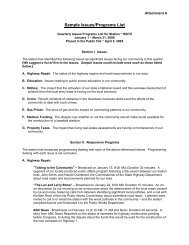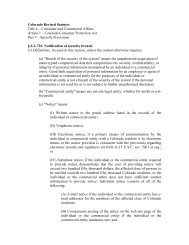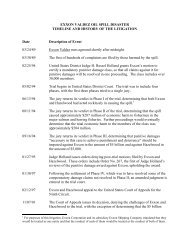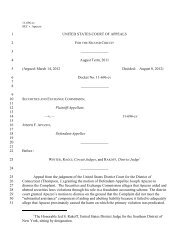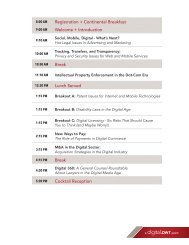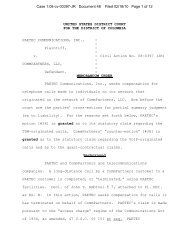QUANTA SERVICES INC, QUANTA SERVICES MANAGEMENT ...
QUANTA SERVICES INC, QUANTA SERVICES MANAGEMENT ...
QUANTA SERVICES INC, QUANTA SERVICES MANAGEMENT ...
Create successful ePaper yourself
Turn your PDF publications into a flip-book with our unique Google optimized e-Paper software.
ALEX RYGIEL, ANALYST, FBR & CO.: Nice quarter, gentlemen. Two quick questions. First, you mentioned in your opening remarks that you're seeing your<br />
customer base broaden and one of the strengths of Quanta through the years has been that your customer base has already been very broad. Can you<br />
comment a little bit further on that comment in your opening remarks?<br />
JIM O'NEIL: Yes. Well I don't want to give any names, Alex. I think that the current environment is, for our customers, that they are under more pressures<br />
to get projects done on time and under budget or on budget and it's very important, and we've had more discussions with people that we haven't<br />
traditionally worked with in the past, and we believe that there will be opportunities that we will execute on, because we have the capabilities to get their<br />
projects done. On time and on budget. And we have the resources to do that.<br />
ALEX RYGIEL: That's great.<br />
JIM O'NEIL: You will see some new customers for certain in 2013.<br />
ALEX RYGIEL: Excellent. And then secondly, can we dig a little bit deeper into the pipeline business? Excellent quarter, 5.8% operating margin, up nicely<br />
from the second quarter. Can you put that into perspective and maybe give us some directional guidance on the mix of long-haul, large-diameter versus<br />
shale work this year, and possibly what that mix could look like next year, and how it could help or hurt margins?<br />
JIM O'NEIL: I would say that for 2012, all of our work is shale-related. And we've done very well. We established a presence about 18 months ago and from<br />
that point, we built momentum, and we've got more volume and better margins because of that. I would not think that a 50/50 mix next year would be out<br />
of the question, but that's not going to be one plus one equals two. It'll probably be one plus one equals 1.5, but we will see some big pipe opportunities<br />
next year that could be a 50/50 mix potentially, big pipe versus soft shale work.<br />
OPERATOR: Your next question comes from the line of Will Gabrielski of Lazard. Please go ahead.<br />
WILL GABRIELSKI, ANALYST, LAZARD CAPITAL MARKETS: Can you talk about any impact you may have seen as the quarter, Q3, went along in the shales?<br />
Did you see any change in activity levels based on what's happening with the rig count, or some of the commentary from the E&Ps around expensing or<br />
exhausting their capital budgets for this year, and maybe waiting until next year to start spending again?<br />
JIM O'NEIL: No, Will. We have not seen that. This E&P guys that we're dealing with are not going to shut rigs down for the quarter and start back up in<br />
January. That's inefficient. We continue to see the drilling rig count, particularly on the horizontal rigs in the liquid-rich plays, the pickup continues to be<br />
strong and we have not seen any pullback in that activity.<br />
WILL GABRIELSKI: Okay, and then for my follow-up. I was just wondering if you could talk about the reliability side of your business? [Mozan] Transmission<br />
tracks assets every quarter, just to see how it's tracking, but the enforcement of some of the NERC reliability rules, and how that's trending, and what the<br />
margins are looking like on that work right now?<br />
JIM O'NEIL: Well, it's 50% of our transmission business, and it's growing, if not the same, more than what our big transmission business is growing this<br />
year. It's significant and it's going to be here for several years. And our customers are just on the very front end of spending money to comply with NERC<br />
reliability standards. And then on top of that, you've got FERC 1000, which could impact us in 2014 and 2015, you have the coal switching to natural gas<br />
projects, which is going to be 30 to 60 mile pipe segment lines that need to be built off a new gas-fired generation that's going to be in the small<br />
transmission category so we've got a significant amount of opportunities in the small transmission market that is being driven by regulation.<br />
And that's going to help pipeline too, to because you're going to have to build gas pipelines, compressor stations, and pump stations and all of that, so that's<br />
really going to support our pipeline business as well. It's all good stuff. Good drivers right now in our business.<br />
OPERATOR: Your next question comes from the line of Noelle Dilts of Stifel Nicholas. Please go ahead.<br />
NOELLE DILTS, ANALYST, STIFEL NICOLAUS: I was hoping you could speak a little bit about the opportunities that you're seeing in Canada, in terms of both<br />
electrical and pipeline, and how that compares to US? And I've been hearing that, on the pipeline side in particular, we've been hearing that labor is tight in<br />
Canada. I'm wondering if you're seeing a shift toward negotiation and away from competitive bid in the Canadian market, on the pipeline side?<br />
JIM O'NEIL: I can just tell you that the same drivers in the US are in Canada today, as far as both electric transmission and on pipeline. It's a very active<br />
market and we are well-positioned in Canada from a competitive standpoint to take advantage of those opportunities as they present themselves. Really in<br />
almost every province in Canada, there's opportunities. It's the same drivers that we see in the US, it's just about 18 months behind the activity here in the<br />
States.<br />
NOELLE DILTS: On the labor side, is the tightness of labor pool, is it similar to the US or is it a little bit tighter in Canada?<br />
JIM O'NEIL: I would say it as tight if not tighter in Canada than it is in the US. Everyone is going through a skilled labor, both the pipeline industry and the<br />
electric industry are going through labor shortfalls right now, as the demand continues to increase for the services our customers need.<br />
OPERATOR: Your next question comes from the line of Andy Wittmann of Robert W. Baird. Please go ahead.<br />
Page 11 of 26<br />
ANDREW WITTMANN, ANALYST, ROBERT W. BAIRD & COMPANY, <strong>INC</strong>.: I wanted to dig into the pricing environment in the electric business. Specifically,<br />
there's a fairly large project that went out this past quarter that your name had been circled around -- you have been a higher-quality service provider and<br />
this is a project that I assume you did not want to price it at some of those levels that we're seeing in it. Can you just talk about the level of competition on<br />
price today, and what maybe your passing on that job means for the rest of the environment that you might be looking at in terms of other projects?<br />
JIM O'NEIL: Yes, and you can't take one project and think that's going to set pricing for the industry. It's a very regional dynamic and it's also depends upon<br />
the size of the line, the scope of the line, what type of geography we're in, so we're not going to win every job. I can tell you that our philosophy on pricing<br />
has not changed. If anything, prices could go up because the demand for our services continues to increase. So, I wouldn't read anything into us winning or<br />
not winning a project that everybody had circled for us to win. I just think that you can't do that. The pricing dynamic in the industry still continues to be<br />
very strong.<br />
http://search.proquest.com.ezproxy.spl.org:2048/printviewfile?accountid=1135<br />
12/6/2012




